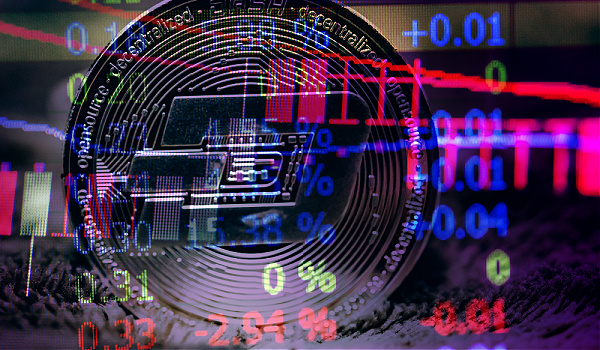By Sarson Funds, Inc.
The first third of 2022 was marked by some extraordinary market volatility, and not just in crypto.
Markets sold off and neared or entered bear market territory across several asset classes, including traditional bonds and equities.
“This is a tough market for investors, and a tough market for companies in general,” said David Gamble, Portfolio Manager at Sarson Funds, a crypto asset manager and education platform for financial advisors. “We’re not in the same climate we were in last year, even if we’re talking about traditional markets where we have companies like Teladoc that have been down considerably, sometimes losing 75% on the year… it’s really required investors to do their homework and pick their spots.”
Gamble believes that the current bout of volatility was spurred by inflation reaching 8.5% and the prolonged conflict in Ukraine.
In current conditions investors cannot afford to buy into the market and add to their positions blindly, said Gamble. Especially in crypto.
“It amplifies all of the reasons why it is important to make sure you’re doing your homework on all the protocols, projects, and companies in this space, and make sure you’re position-sizing correctly,” he said.
Cryptocurrency is volatile by virtue of its design—it trades everywhere, around the clock, with millions of participants—and it’s novelty–it’s only been around for around 14 years.
It’s hard to say how mature the cryptocurrency space is—it’s certainly gained a lot of attention, but Gamble argues that it’s also relatively small.
“The entire digital currency space is literally the value of Microsoft, so if you think about it that way, there’s a lot of upside potential there,” he said.
In fact, since the first cryptocurrency, bitcoin, was born in 2008, it’s “never seen a natural bear market,” said Gamble.
“Since then, bitcoin has seen choppy movements and volatility, however, its trajectory has only been within what we would consider an upwards-moving market,” he said. “What we’re seeing is a big testament to what bitcoin has to offer.”
Messaging For a Bumpy Ride
After its spot price peaked at a high of over $19,650 in 2017, bitcoin fell into a swoon, notching a series of bottoms – around $3,183 in December 2018, then $5,165 in March 2020, before soaring over $62,383 in March 2021 and an all-time high of over $64,400 in November.
Today, bitcoin trading is “choppy,” according to Gamble, oscillating around a level well below that of its 2021 peaks. It has also, at times, correlated at times with the performance of U.S. equities, especially during downturns.
“We’ve seen choppy movement like this from bitcoin in the past, whether it be the market in 2013, 2015 or even 2018,” he said. “The choppy movement actually has led to a lot more investment in bitcoin because it has offered later investors the ability to see an opportunity to capture potential upside movement. 2018 was a case in point when we saw the price break the $6,000 threshold. It preceded a small mini-market panic in stock indices, especially the Nasdaq. Bitcoin performance may be turning into an indicator for where traditional markets are going.”
Bitcoin and equities will decouple with time, said Gamble, as bitcoin’s natural scarcity becomes more influential over its price and more users adopt it for everyday use.
Investment in any asset class, at any time, is an act of optimism, an expression of the belief that something good will happen. Investment during volatile times is also an act of courage, said Gamble.
In cryptocurrency, Gamble said there’s reason to think that the adoption curve will move in the right direction, citing countries like Panama and the Central African Republic, who have moved to embrace cryptocurrencies, following the lead of El Salvador.
“Sometimes repricing makes for massive opportunity, and if I had to guess, I would say that’s what we’re in, an age of massive opportunity,” he said. “We’re seeing flexibility from governments and regulators.”
Investors should keep in mind their time horizon, said Gamble, and get over the dreams of bitcoin and most other digital assets being get-rich-quick schemes.
“There’s no such thing,” he said. “The days of bitcoin being a quick fix to your financial problems are at an end. Now it’s about understanding the longevity of the digital currency space and where it’s headed. But I assure you that in the digital currency markets, we’re still in the infancy. It’s very early. There’s going to be a lot of volatility, and a lot of upside.”
How To Handle Volatility
There are a few ways of addressing the volatility in cryptocurrency investing, including implementing products designed to limit overall volatility or hedge downside volatility in one or more digital tokens.
As an investor himself, Gamble prefers monitoring the amount that investors allocate to digital assets according to their risk profile and diversifying across digital assets and other asset classes.
“It’s very important to position-size correctly and scale back appropriately for risk-averse investors,” he said. “We take into account market sentiment. When we are head-in to the market, we think about where we are and how we should react when they move. Sometimes that requires us to rebalance or scale back in terms of position size. It’s very important to stay within your risk tolerance and also to potentially have some cash there not only as a reserve, but if and when bitcoin goes down another 20% or 40% to catch some of those opportunities.”
Not only do any positions in crypto need to be resized and rebalanced periodically, but they need to be changed in accordance with the rest of an investor’s portfolio and financial strategy. Ideally, an investor will be comfortable with the portfolio impact of a major draw-down in crypto.
Holding cash allows investors to capture moments –often very brief moments – where bitcoin and other cryptocurrencies experience what Gamble calls a “blow-off bottom.” In this scenario, a market sell-off becomes a panic.
“That’s what it comes down to, the repricing of those markets will present some massive opportunities for multi-generational wealth building—opportunities we may not see again for a very long time.”








